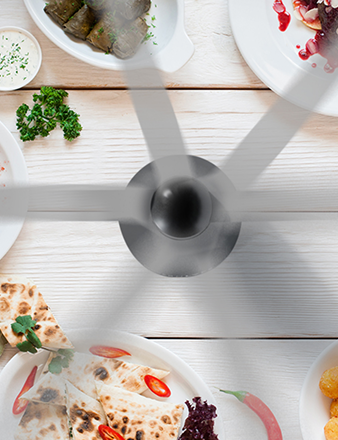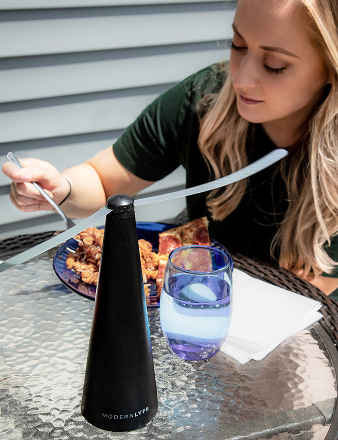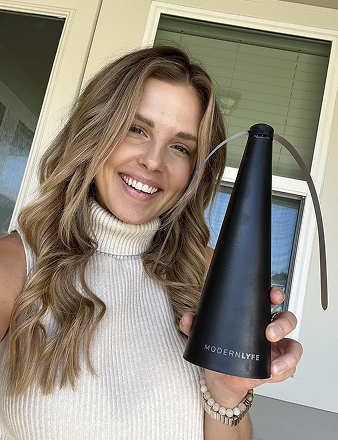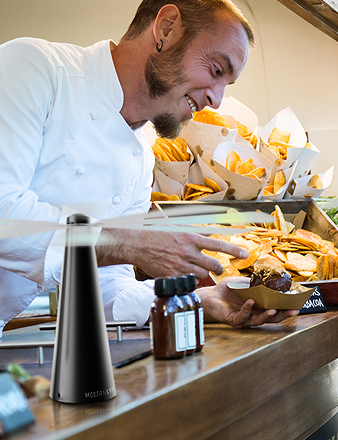To get rid of fruit flies fast, you need a two-part attack. First, trap the adults buzzing around your kitchen. Second, destroy their breeding grounds. It's a simple, effective strategy that works every time.
You can start right now with a DIY trap using apple cider vinegar and a drop of dish soap. While that trap works its magic, a quick cleaning blitz targeting sink drains and forgotten produce will stop the next generation in its tracks.
Your Immediate Action Plan to Get Rid of Fruit Flies

There's nothing more annoying than a cloud of tiny flies in your kitchen. You want them gone now. The good news is you can make a huge impact in just a few hours using things you already have. This is your emergency response plan for fast relief.
Your first mission is to set a trap. It doesn't need to be fancy. The science is simple: fruit flies are hard-wired to seek out the smell of fermentation, which signals a meal of overripe fruit.
The Classic Apple Cider Vinegar Trap
This method is a classic for a reason: it's incredibly effective. Pour about an inch of apple cider vinegar into a small jar or bowl. That sweet, fermented scent is an invitation they can't refuse.
Now for the key ingredient: add a single drop of dish soap. The soap breaks the surface tension of the vinegar. When the flies land for a drink, they'll sink instead of just walking on the surface. Set this trap wherever you see the most activity—near the fruit bowl or kitchen sink is your best bet.
Pro Tip: Gently warm the vinegar in the microwave for about 10 seconds before adding the soap to make it even more potent. The heat amplifies the scent, making your trap irresistible to any fruit flies nearby.
Target and Sanitize Breeding Hotspots
While your trap catches adult flies, you need to attack the source. A single female fruit fly can lay up to 500 eggs, and she's looking for any moist, fermenting organic matter to do it. Trapping adults is only a temporary fix; you have to destroy the nursery.
If you're looking for more robust solutions, our guide on the best fruit fly trap to buy offers some great commercial options.
For now, grab your cleaning supplies and immediately focus on these common breeding grounds. Finding and eliminating these hotspots is non-negotiable for getting rid of fruit flies for good. Here's a quick checklist to help you pinpoint the sources in your home.
Immediate Fruit Fly Hotspot Checklist
| Hotspot Area | What to Look For | Immediate Action |
|---|---|---|
| Kitchen Sink & Drain | Sticky residue, small food particles, gunk in the garbage disposal. | Pour a kettle of boiling water down the drain. Follow with a cleaner if needed. |
| Countertop Produce | Any fruit or vegetable that is soft, bruised, or starting to leak juices. | Immediately discard the item in a sealed bag and take it outside. |
| Trash & Recycling Bins | Spilled soda, beer, or juice residue. Sticky film at the bottom of the can. | Empty the bins, then wash and dry them thoroughly before adding a new liner. |
| Damp Sponges & Cloths | Sponges or dish rags that stay wet and have a sour smell. | Wring them out completely after each use. Microwave damp sponges for 60 seconds to kill larvae. |
By running through this checklist, you're not just cleaning—you're actively destroying the places where fruit flies multiply. This deep clean, combined with a few well-placed traps, is the fastest way to reclaim your kitchen.
Where Did All These Fruit Flies Come From?
It's a common kitchen mystery. One minute, everything's fine. The next, a cloud of tiny flies has appeared over your fruit bowl. It feels like they came from nowhere, but the truth is, they were just waiting for an invitation.
To win the war against fruit flies, you have to understand what makes them tick. It's not just about one brown banana. These pests are programmed to seek out any hint of fermentation, moisture, or hidden gunk. For them, that's not just dinner—it's the perfect place to start a family.
They're Attracted to Fermentation
Fruit flies have a powerful sense of smell, specifically tuned to detect the alcohol produced as things decay. That’s why a mushy peach or an apple core in the trash is like a five-star restaurant beacon. They are chasing fermentation, not just sugar.
It doesn't take much. An old potato in the back of a cupboard or a tiny splash of spilled wine is all it takes to send the signal. Even decorative fruit palm tree displays can become ground zero once the fruit starts to turn. As soon as one fly finds a spot, a swarm isn't far behind.
They Breed in Moisture and Hidden Gunk
The fruit bowl is just the beginning. To multiply, fruit flies need damp, decaying matter to lay their eggs. Their life cycle is incredibly fast. A single female can lay up to 500 eggs, which can hatch and grow into flying adults in just over a week. You have to destroy their nurseries.
Think beyond the obvious and check these common hotspots:
- Sink Drains: Bits of food get caught in the sludge, creating a perfectly moist, fermenting breeding ground.
- Wet Sponges and Dishcloths: A damp sponge left by the sink is a "vacancy" sign for a fruit fly nursery.
- Garbage Disposals: Gunk trapped under the blades is a notorious hideout for fermenting scraps.
- Recycling Bins: Leftover soda or beer residue in an unrinsed can is a feast for them.
Even a damp mop left in a bucket can become a problem. Cutting off these sources of moisture and food is the most effective move you can make.
This isn't just a kitchen problem. Fruit flies are a massive agricultural and economic issue worldwide. Their ability to infest crops makes them far more than a simple household annoyance.
The bigger picture shows why control is so important. These pests have a history of causing major disruptions. Recently, the United States had its worst invasive fruit fly outbreak in 70 years, forcing the federal government to spend over $103.5 million to combat it. With billions in potential economic losses at stake, you can learn more about the large-scale battle against these invasive pests and see why stopping them is a high priority.
Crafting DIY Traps That Genuinely Work
When you're trying to get rid of fruit flies, the best solutions are often the ones you make yourself. You can build a highly effective trap with items already in your kitchen. It’s all about creating a lure they can't ignore.
A good trap needs two things: an enticing scent to draw them in and a way to ensure they can't leave. The goal is to break their ridiculously fast life cycle before a few flies turn into an army.
The Classic Apple Cider Vinegar Trap
This one is a classic for a reason—it works. Fruit flies are drawn to the fermented smell of apple cider vinegar (ACV) because it smells like their favorite meal: rotting fruit.
Just pour an inch of ACV into a small jar or glass. Then, add a single drop of dish soap. The soap is the secret weapon; it breaks the surface tension of the vinegar, so when flies land for a drink, they sink. For more tricks using similar ingredients, check out our guide on making a fly trap with bait.
Pro Tip: Want to make your trap even more powerful? Microwave the vinegar for about 10-15 seconds. Gently warming it releases more of that pungent aroma, making it irresistible. Set it up near the fruit bowl or your sink for the best results.
This infographic breaks down why these DIY traps are so successful.

As you can see, it all comes down to fermentation, moisture, and organic material. That’s the trifecta for a fruit fly problem, and it's why vinegar and wine traps work so well.
Alternative Baits for Your Traps
No apple cider vinegar? No problem. Fruit flies aren't picky, so other fermented liquids work just as well.
- Red Wine Lure: If you have a bottle of red wine with just a little left, leave it out on the counter. The bottle's narrow neck acts as a natural funnel, letting flies in but making it hard for them to fly out.
- Yeast and Sugar Mix: Here's another great option. In a small bowl, dissolve a teaspoon of sugar and a pinch of active dry yeast in some warm water. As the yeast activates, it releases carbon dioxide and that fermented smell fruit flies love.
The fact that these simple home remedies are so effective points to a bigger picture. The global market for fruit fly control is growing fast, not just for homes but for agriculture. By 2033, the market is expected to reach $250 million, largely because of an increased focus on food safety. It puts into perspective how this common kitchen annoyance is a major global issue.
How to Wipe Out Breeding Grounds for Good
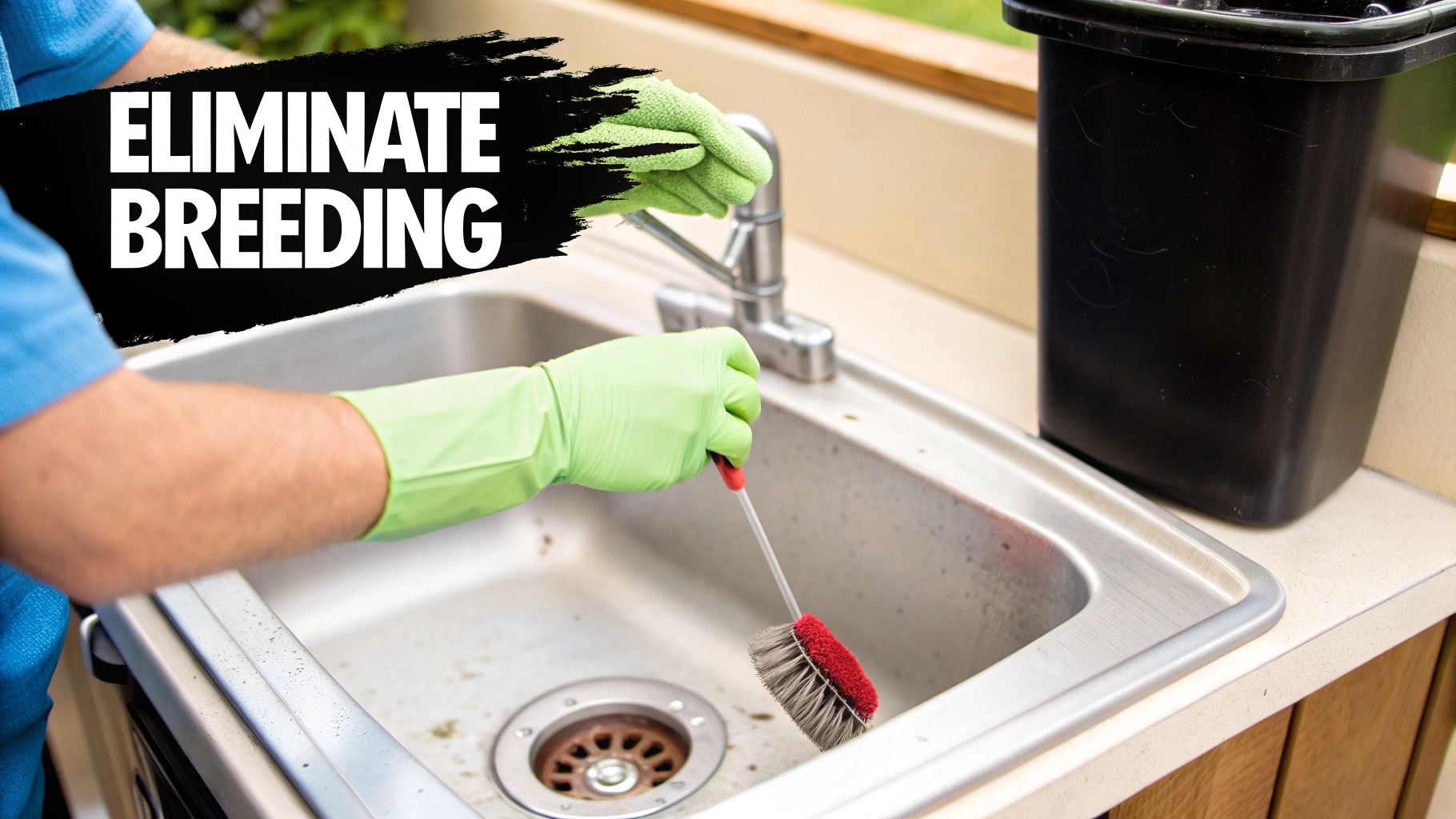
Setting traps is a great way to catch adult flies, but it's a temporary fix. You're dealing with the visible problem, not the source. To win the war, you have to go on the offensive and destroy the places where they lay their eggs. This is the single most crucial step to get rid of them for good.
A single female fruit fly can lay up to 500 eggs. She isn't picky. Any bit of moist, fermenting organic matter is a five-star nursery. It's time to roll up your sleeves and deep clean all the hidden spots you might not think about.
Conquer Your Drains and Disposal
Your kitchen sink is almost always ground zero. It’s dark, damp, and full of tiny food particles trapped in grime, creating a perfect sludge for larvae. A simple rinse won’t cut it; you need to destroy their habitat.
Start by carefully pouring a kettle of boiling water straight down the drain. This loosens built-up gunk. For a deeper clean, follow that with a half-cup of baking soda and a half-cup of white vinegar. Let it fizz for 10-15 minutes, then flush it all with another round of hot water.
Don't forget the garbage disposal. While ice cubes and citrus peels can help, they don't scrub hidden surfaces. With the disposal off, get in there with a long-handled brush. Pay special attention to the underside of the black rubber splash guard—it's a notorious hiding spot for slime.
Remember, the goal is to eliminate the biofilm. That's the sticky, gunky layer clinging to the inside of your pipes where eggs and larvae are hiding. A quick splash of cold water just won't cut it.
Reinforce Your Waste Management
Your trash can and recycling bin are an all-you-can-eat buffet for fruit flies. It’s about more than just taking the trash out regularly; it’s about eliminating the sticky residue that attracts them.
- Rinse Everything: Before tossing cans, bottles, or food containers into recycling, give them a quick rinse. That tiny bit of leftover juice, soda, or beer is a feast for a fruit fly.
- Seal Your Trash: Always use a trash can with a tight-fitting lid. An open bin is a giant welcome sign for pests.
- Deep Clean the Bins: At least once a week, take your bins outside and scrub them with soap and water. A quick disinfectant spray before you put in a new bag adds an extra layer of protection.
Adopt Smart Compost and Produce Habits
Your eco-friendly efforts shouldn't invite a pest infestation. Compost bins, inside or out, can quickly become fruit fly magnets. Understanding the proper composting of food waste is key to ensuring your green habits don't backfire.
When it comes to produce, wash fruits and vegetables as soon as you get them home. This simple step can remove eggs or larvae that hitched a ride from the store. Store ripe produce in the fridge, and get rid of anything bruised or overripe immediately—just put it in a sealed bag before it goes into the trash.
By making these sanitation habits part of your routine, you’ll turn your home into a place where fruit flies simply can't survive.
Long-Term Prevention Strategies to Keep Them Out for Good
You’ve finally cleared your kitchen of fruit flies. Great. The real victory isn't just getting rid of them; it's making sure they never come back.
Winning the battle is one thing; winning the war means shifting from reactive cleaning to proactive prevention. With a few consistent habits, you can make your home a place these pests want to avoid.
The trick is to think like a fruit fly. They are always hunting for their next meal and a place to lay eggs. Your prevention strategy needs to be ongoing, starting the moment you bring groceries home.
Smart Produce Management Habits
One of the most common ways fruit flies enter our homes is by hitching a ride on produce. Tiny, nearly invisible eggs and larvae can be hiding on those fresh fruits and veggies, waiting for the right moment to hatch.
Your first line of defense is simple, yet often skipped.
- Wash Everything Immediately: As soon as you get home from the store, make it a habit to wash all produce under cool, running water. This small step can easily dislodge any freeloading eggs.
- Refrigerate Ripe Fruit: Don't let ripe bananas, peaches, or tomatoes linger on the counter. Once produce hits its peak, move it to the fridge. This slows the fermentation process that fruit flies love.
- Use Proper Storage: Keep potatoes and onions in a cool, dark, and dry place. Avoid leaving them in plastic bags, as moisture can build up and speed up decay.
A proactive approach is always more effective than a reactive one. By creating an environment that doesn't support fruit flies, you eliminate the problem before it starts.
This focus on smart, eco-friendly prevention works on a massive scale. For instance, the Dominican Republic successfully wiped out a major Mediterranean fruit fly infestation in under 10 months using a non-chemical method. You can read more about this impressive eradication program on IAEA.org.
Complement Your Efforts with Modern Technology
While good sanitation is your foundation, adding modern tools can create an excellent final layer of defense. These solutions deter flies without any effort on your part—no chemicals, no work, just a protective barrier around your food and dining areas.
A fly fan is one of the most effective tools available. These devices use soft, spinning blades to create a gentle, consistent airflow. It might seem simple, but this air current makes it incredibly difficult for a fly to land. They're quiet, safe around kids and pets, and work wonders for keeping flies off your dining table or kitchen prep space.
They're especially useful during a family dinner or a backyard barbecue. Wondering how they work? Our article explaining how fly fans work breaks down the simple science behind their success. Adding a couple of these fans to your kitchen and patio effectively creates a no-fly zone, protecting your food and keeping your space pest-free.
Still Got Questions About Fruit Flies?
Even after setting traps and scrubbing your kitchen, some questions might remain. Battling fruit flies can be frustrating, so let's clear up a few of the most common issues.
Why Are Fruit Flies Here If I Don't Have Any Fruit Out?
This is a common frustration. You’ve put away all the produce and wiped everything down, but the flies are still there. What gives?
The reality is, fruit flies aren't just after fruit. They're drawn to any fermenting organic matter. The source is almost always something you haven't thought of.
It could be the gunk in your sink drain, a damp sponge, or the sticky residue at the bottom of the recycling bin from a soda can. They can even breed in the soil of overwatered houseplants. A tiny splash of juice behind the fridge is a five-star resort for these pests.
How Long Until These Things Are Actually Gone?
If you’ve set good traps and cleaned thoroughly, you should see a massive drop in the adult fly population within 24 to 48 hours.
But don't declare victory yet. The entire fruit fly life cycle, from egg to adult, takes about a week. You have to keep traps fresh and stay on top of your cleaning for at least one to two weeks. This is the only way to catch the next generation as they hatch and truly break the cycle for good.
Are Fruit Flies Actually Dangerous?
For the most part, fruit flies are just incredibly annoying. But they can pose a small health risk.
Think about where they hang out: garbage disposals, compost heaps, and drains. Then they fly from those spots and land on your food. Because of this, they can potentially transfer bacteria like E. coli and Salmonella.
The odds of getting sick from a fruit fly are low, but it's more than enough reason to get them out of your kitchen and keep your home clean and healthy.
For a modern, chemical-free way to protect your dining spaces, check out the elegant and effective fly fans from MODERN LYFE. See how our technology can create a permanent no-fly zone in your home by visiting our website.

